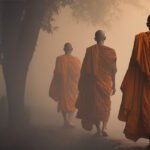With the culmination of countless eons of perfecting the perfections, the Blessed One wielded the power of Dhamma, triumphing over all seen and unseen adversaries. He is the King of the Dhamma, the sovereign ruler of this profound teaching. Just as a king governs his kingdom by issuing and enforcing decrees, the Buddha’s teachings hold immense authority and influence. All his disciples, like subjects in a kingdom, live in accordance with the Dhamma and Discipline proclaimed by him. His well-proclaimed teachings are known as the Wheel of Dhamma, encompassing the Four Noble Truths.
In his first discourse, known as the Discourse on Setting in Motion the Wheel of Dhamma (Dhammacakkappavattana Sutta), delivered to the five monks who attended to him during his self-mortification practices, the Buddha proclaimed that a monk should abandon the extremes of sensual indulgence and self-mortification. Instead, he advocated for the Noble Eightfold Path as the middle way leading to insight, direct knowledge, realization, enlightenment, and Nibbāna. This noble path commences with right view.
“What, monks, is right view (sammā diṭṭhi)? It is the realization of suffering (dukkhe ñāṇaṃ), the realization of the origin of suffering (dukkhasamudaye ñāṇaṃ), the realization of the cessation of suffering (dukkhanirodhe ñāṇaṃ), and the realization of the way leading to the cessation of suffering (dukkhanirodhagāminiyā paṭipadāya ñāṇaṃ). This, monks, is called right view.” (SN 45:8)
The Buddha initially taught right view, the first factor of the Noble Eightfold Path, which entails understanding the Four Noble Truths as fundamental truths of existence. Regarding suffering, the Buddha expounded:
“Monks, this is the noble truth of suffering: birth is suffering, aging is suffering, sickness and disease are suffering, death is suffering; union with displeasing people and things is suffering; separation from pleasing people and things is suffering; not obtaining what one desires is suffering; in brief, the five aggregates affected by clinging are suffering.”
In his first discourse, the Buddha succinctly explained the noble truth of suffering. The wise can derive deep understanding from these concise words. He then elucidated the cause underlying all forms of suffering:
“Now, monks, this is the noble truth of the origin of suffering: it is the craving that leads to renewed existence, accompanied by delight and lust, seeking pleasure here and there; that is, craving for sensual pleasures, craving for existence, craving for non-existence.”
With his remarkable wisdom, the Buddha accurately identified the cause of suffering, which had remained elusive even to deities until his appearance. He revealed that even some devas believed in a supreme deva with greater power who had created them. Even today, many people adhere to the belief that a powerful creator god deliberately fashioned the entire world, including human beings, animals, plants, forests, rivers, and streams, subjugating the world under divine authority. The quest to comprehend the origin of sentient beings had eluded all attempts, defying the wildest imaginings. However, the Buddha, with his extraordinary wisdom, unraveled the enigma of life.
In this world, which includes celestial beings, the truth is being unveiled. Beings who suffer learn about the cause of suffering through the Buddha’s teachings. The suffering they endure is not a deity’s creation, nor is it a mere chance occurrence or the result of one’s volition. Rather, it is craving that fuels suffering. By uprooting the root cause of a particular problem, the problem itself is resolved. Subsequently, the Buddha stated the third noble truth
“Now, monks, this is the noble truth of the cessation of suffering: it is the complete fading away and cessation of that very craving, its abandonment, relinquishment, freedom from it, non-reliance on it.”
From the Buddha’s first discourse, beings in the world acquired the answer to the predicament of suffering. They gained clarity on what suffering is, its cause, and how it can be eliminated. This brought forth the most critical question: how to eradicate the threefold craving and what needs to be done to achieve this. “Now, monks, this is the noble truth of the way leading to the cessation of suffering: it is this Noble Eightfold Path, namely, right view, right intention, right speech, right action, right livelihood, right effort, right mindfulness, and right concentration.” (SN 56:11)
There exists no other solution in the entire universe besides the practice of the Noble Eightfold Path. It is the sole remedy. Thus, the perplexing puzzle that had confounded deities and humans alike was entirely resolved. In his first discourse, the Buddha expounded on right view, the first factor of the Noble Eightfold Path.
Furthermore, the Buddha revealed that he gained realization of each of the Four Noble Truths in three phases: sacca ñāṇa (knowledge of the truth), kicca ñāṇa (knowledge of what needs to be done), and kata ñāṇa (knowledge of what has been done). Through the complete realization of the Four Noble Truths, the Buddha attained the vision of Dhamma, knowledge, wisdom, true understanding, and radiant illumination. Having fully comprehended the Four Noble Truths, the Buddha resolutely declared his attainment of unsurpassed, perfect enlightenment. He proclaimed the unshakability of his liberated mind, the cessation of rebirth, the fulfilled spiritual life, the accomplishment of what needed to be done to attain Nibbāna, and the absence of any further existence. He declared that this was his final birth, with no more future rebirths. Moreover, he proclaimed the attainment of knowledge and vision of liberation concerning the Four Noble Truths. (SN 56:11)
The Blessed One’s first discourse, the Dhammacakkappavattana Sutta, met with success. While listening to the discourse, the eldest of the five monks achieved the fruition of stream-entry, gaining sacca ñāṇa regarding the Four Noble Truths. This discourse provides a clear explanation of the attainment of stream-entry.
The Venerable Koṇḍañña achieved realization by attentively listening to the Dhamma and wisely contemplating it. He attained the first factor of the Noble Eightfold Path, right view. Sota—stream, the stream of Dhamma leading to Nibbāna. Āpanno—entered. Sotāpanno—stream-enterer, one who has entered the stream of Dhamma leading to Nibbāna.
The wonders that unfolded during the Buddha’s first discourse were not limited to this attainment alone. One hundred and eighty million Brahmās, who had assembled to listen, also gained right view. They experienced the immaculate vision of the Dhamma, free from any impurities, realizing that all phenomena arise due to causes and cease with the cessation of those causes. All of them attained the fruition of stream-entry.
The Wheel of Dhamma is indeed magnificent and wondrous! It had never been heard before by beings in the world. Those individuals blessed with merit and cultivated virtues throughout their journey in saṃsāra are the ones who come to realize the profound truths of the Dhamma. The Wheel of Dhamma is comparable to the rising sun, casting its illuminating rays upon flower buds eagerly awaiting their blossoming.
When the Blessed One set the Wheel of Dhamma in motion, the devas residing on Earth raised a cry, exclaiming, “At Benares, in the Deer Park at Isipatana, the Blessed One has set in motion this unparalleled Wheel of Dhamma, which cannot be reversed by any ascetic, brahmin, deva, Māra, Brahmā, or any being in the world.” The cry of the Earth-dwelling devas was heard by the devas inhabiting the realms of the Four Great Kings, extending all the way up to the devas of the Akaniṭṭha Brahmā world, who echoed the same exclamation.
Such was the power of truth encapsulated in the Buddha’s words that, during the delivery of this discourse, the entire tenthousandfold world system trembled and quaked. “At that moment, in that instant, at that second, the cry reverberated throughout the Akaniṭṭha Brahmā world, and this ten-thousandfold world system shook, quivered, and trembled. An immeasurable and glorious radiance, surpassing the divine splendor of the devas, illuminated the world.”
Thus, on an Esala full moon poya day, the magnificent Wheel of Dhamma was set in motion by the Buddha.
By a Venerable Monk of the Mahamevnawa Buddhist Monastery












Recent Comments